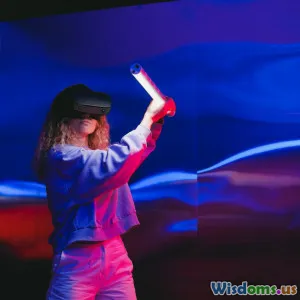
Exploring Virtual Reality in Modern Gaming
7 min read A deep dive into virtual reality's transformative role in modern gaming and its impact on player experience. (0 Reviews)
Exploring Virtual Reality in Modern Gaming
Introduction
Imagine stepping inside your favorite game—not just controlling the action through a screen but physically feeling like you're part of the world. This is the promise of Virtual Reality (VR) in modern gaming: to transport players beyond traditional boundaries and into fully immersive digital universes. Since its humble beginnings, VR has evolved dramatically, shaping how we play, interact, and experience games today.
In this article, we'll explore the revolutionary technology behind VR in gaming, look at pioneering games and hardware, and examine how VR is redefining player engagement and the industry's future.
The Evolution of Virtual Reality in Gaming
From Concept to Commercialization
The concept of virtual reality dates back several decades, with early experiments in the 1960s, such as Ivan Sutherland’s "Sword of Damocles" headset, laying the groundwork. However, it wasn’t until the 2010s that VR became accessible for gamers, thanks to advancements in display technology, motion tracking, and processing power.
The launch of Oculus Rift's Kickstarter campaign in 2012 reignited public interest, followed by major players like Sony’s PlayStation VR in 2016 and Valve Index in 2019. These devices provided affordable yet sophisticated means for everyday gamers to experience VR firsthand.
Increasing Immersion Through Technology
Modern VR systems use stereoscopic displays, motion sensors, and spatial audio to immerse the player in a 3D environment. This sensory input trickery engenders a sense of "presence," making players feel they’ve truly stepped inside the game world.
Examples such as the Valve Index’s high refresh rates (up to 144Hz) and precise finger tracking enhance realism by reducing motion sickness and replicating natural hand gestures—a breakthrough compared to older controllers.
Key Aspects Driving VR’s Growth in Gaming
Game Development Tailored for VR
VR is not just a new platform but demands a fundamental rethink in game design. Developers focus on minimizing player discomfort, managing movement schemes to prevent nausea, and exploiting VR’s spatial capabilities.
Thirty days after the debut of "Half-Life: Alyx" in 2020, Valve reported strong sales and widespread critical acclaim, with some calling it the best VR game to date. Its success highlighted how story-driven, first-person adventures could leverage VR’s unique strengths.
Other games like "Beat Saber," a rhythm-based lightsaber game, have garnered millions by combining intuitive VR mechanics with addictive gameplay, making VR appealing to both hardcore and casual players.
Hardware Innovations
Performance improvements in VR headsets directly influence gaming quality. Wireless headsets like the Oculus Quest 2 removed the tethered limitation, offering freedom of movement without a PC connection.
Additionally, haptic feedback suits and gloves developed by companies like HaptX promise to augment tactile sensations, enabling gamers to feel textures and impacts within virtual environments.
Expanding Player Communities and Esports
VR gaming communities are growing quickly, propelled by social VR games like "Rec Room," where players interact in shared virtual spaces, host events, or engage in multiplayer matches. This social aspect breaks isolation and fosters global connections.
Esports have not remained untouched; titles such as "Echo Arena" have competitive scenes with professional leagues, further legitimizing VR's place in the competitive gaming landscape.
Challenges Facing VR Gaming
Despite impressive advancements, VR still faces several hurdles:
- High Entry Costs: Premium VR setups remain expensive for many gamers.
- Motion Sickness: Vestibular mismatches cause discomfort for some users.
- Limited Game Library: While growing, the VR-exclusive content pool is smaller than traditional platforms.
- Physical Space Requirements: Some games need ample clear space, limiting playability.
Developers and manufacturers continually strive to mitigate these limitations. For instance, software updates and ergonomic designs have reduced motion sickness rates considerably.
The Future: What’s Next for VR in Gaming?
Industry experts forecast that VR will integrate further with AI and cloud gaming, enhancing game complexity and reducing hardware reliance.
Sony’s announcement of the upcoming PS VR2, boasting 4K HDR displays and eye-tracking, indicates next-gen VR is ready to blur lines between reality and simulation even more.
Moreover, developments in augmented reality (AR) and mixed reality (MR) hint at hybrid experiences—where VR seamlessly interacts with the real world, opening new artistic and gameplay possibilities.
The continuous expansion of 5G networks also means reduced latency and high bandwidth for multiplayer VR games, fueling immersive social gaming on a global scale.
Conclusion
Virtual reality is revolutionizing modern gaming not just as another medium but as a transformative experience that invades multiple senses and deepens connection to digital worlds. From technical breakthroughs in hardware to iconic VR titles reshaping narratives and interaction, the pace of development is breathtaking.
Although challenges remain, the growing adoption and innovation in VR gaming signal a vibrant future where boundaries between reality and the virtual merge closer than ever. Whether you're a casual gamer curious about VR or a developer seeking inspiration, this immersive technology promises to redefine how stories are told and worlds are experienced.
Step into VR—because gaming has never been this close to reality.
Rate the Post
User Reviews
Popular Posts


















